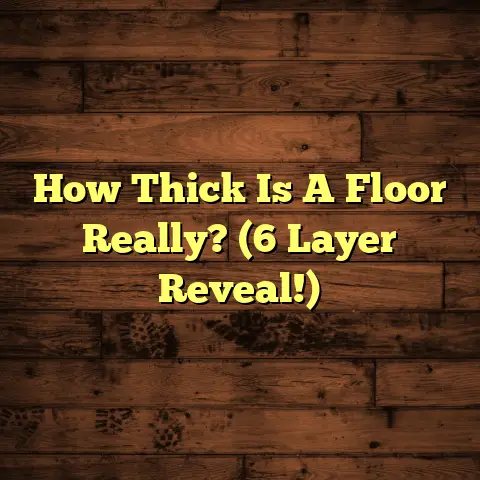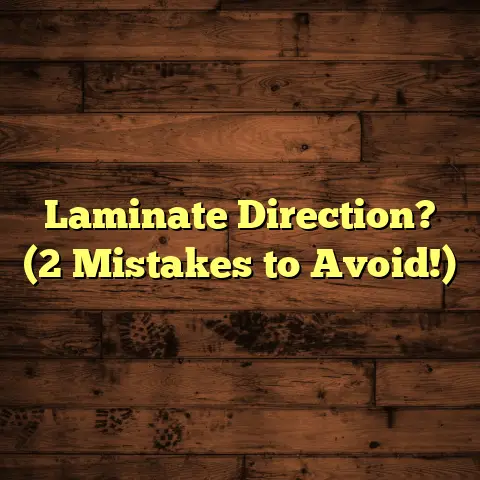Top Water-based Stains For Wood Floors? (Explained)
Sustainability is becoming a pivotal consideration for many homeowners and contractors alike.
As I’ve navigated through the flooring industry over the years, I’ve seen a noticeable shift toward environmentally friendly products.
Water-based stains for wood floors are leading the charge, providing a perfect blend of aesthetics and eco-consciousness.
These stains are not only low in volatile organic compounds (VOCs), making them less harmful to indoor air quality, but they also enhance the natural beauty of wood, allowing its character to shine through.
My journey with water-based stains has been quite the adventure.
From residential renovations to commercial installations, I’ve experimented with various brands and techniques, each experience teaching me something new.
In this detailed exploration, I’ll share my insights into the top water-based stains available, along with tips on application, maintenance, and much more.
Why Water-Based Stains?
Water-based stains have gained popularity for numerous reasons.
One of the most appealing aspects is their quick drying time, which allows projects to move forward without long delays.
For example, I worked on a large residential project where timing was crucial due to the client’s moving schedule.
Using a water-based stain meant we could apply the stain and finish within a single day, significantly reducing downtime.
The variety of colors also plays a significant role in their appeal.
With options ranging from deep espresso to light ash shades, clients have the flexibility to choose a hue that perfectly complements their decor.
I recall a project where the homeowner wanted a soft gray finish to match her modern aesthetic.
After trying several samples, we found a water-based stain that provided just the right look, enhancing rather than overpowering the wood grain.
My Top Picks for Water-Based Stains
Over the years, I’ve tested numerous brands and products.
Here are my top recommendations based on personal experience:
1. Minwax PolyShades
One of my go-to choices is Minwax PolyShades.
It serves as both a stain and a protective finish, simplifying the process.
- Cost: Approximately $15 per quart
- Drying Time: 2 hours
- Coverage: 100 sq ft per quart
In one project, I used PolyShades on a set of oak stairs.
The color turned out beautifully, and the finish held up well against foot traffic.
However, I did encounter challenges ensuring even coverage; I found that applying it with a high-quality brush helped mitigate this issue.
2. Varathane Water-Based Stain
Varathane is another favorite of mine due to its exceptional color range and ease of application.
- Cost: About $12 per quart
- Drying Time: 1 hour
- Coverage: 150 sq ft per quart
I once used Varathane for a client who wanted a rich walnut finish for their dining room table.
The consistency helped prevent drips, and the end result was stunning.
However, I learned that applying multiple thin coats can enhance the color depth significantly.
3. General Finishes Water-Based Stain
Known for durability and excellent coverage, General Finishes is a brand I often recommend.
- Cost: Around $28 per quart
- Drying Time: 2 hours
- Coverage: 125 sq ft per quart
In one instance, I used General Finishes for a high-traffic area in a commercial space.
The stain not only provided an attractive finish but also held up remarkably well over time.
While it’s pricier than others, its longevity often justifies the investment.
Application Techniques
Getting the best results from water-based stains requires careful application.
Here are some techniques I’ve honed over the years:
- Surface Preparation: Properly preparing the wood surface is critical.
I usually start with 120-grit sandpaper followed by 220-grit for a smooth finish.
This step is essential for even stain absorption. - Test Samples: Before committing to a stain color, I always create test samples on scrap pieces of wood or inconspicuous areas.
This helps clients visualize how the color will look in their space under different lighting conditions. - Application Method: I find that using a foam brush or lint-free cloth works best for applying water-based stains.
Long strokes help in achieving an even coat while blending sections prevents lap marks. - Ventilation: Even though water-based stains are low in VOCs, ensuring good ventilation during application is essential.
I typically open windows or use fans to maintain airflow. - Timing: Be mindful of drying times in different weather conditions.
During particularly humid days, I’ve noticed that stains take longer to dry.
Adjusting my schedule accordingly has helped me avoid delays.
Challenges and Learning Moments
Every project comes with its own set of challenges.
One significant hurdle I’ve encountered is working in homes where humidity levels fluctuate dramatically.
In such cases, it’s crucial to adjust expectations regarding drying times and final appearance.
For instance, during one summer project in a coastal area with high humidity, I found that the water-based stain took nearly three hours to dry instead of the typical one hour.
This delay pushed back subsequent steps in the installation process, forcing me to communicate with my client about the changes in schedule.
Another issue I’ve faced is client concerns regarding color fading over time.
While water-based stains generally hold up well, emphasizing regular maintenance is key.
I always advise clients to clean their floors regularly and reapply stain or finish as needed to keep their surfaces looking fresh.
Cost Estimation with FloorTally
Managing costs effectively is essential for any flooring contractor.
FloorTally has become my trusted partner in this aspect.
This tool simplifies cost estimations by pulling in local material prices and labor rates.
For example, during a recent kitchen renovation project, I had to provide an estimate for re-staining existing hardwood floors and installing new cabinetry.
By inputting square footage and desired materials into FloorTally, I received a detailed breakdown that included everything from stain costs to labor expenses and potential waste factors.
This level of precision allows me to present realistic budgets to my clients upfront, building trust and transparency throughout the project.
Maintenance Tips for Water-Based Stains
Once the staining process is complete, proper maintenance becomes crucial to prolonging the life of the finish:
- Regular Cleaning: I recommend using a soft broom or vacuum without a beater bar to remove dirt and debris regularly.
- Damp Mopping: Occasionally damp mop with a solution formulated specifically for wood floors.
Avoid soaking the floor as excessive moisture can damage the wood over time. - Avoid Harsh Chemicals: Steer clear of ammonia-based or abrasive cleaners that can wear down the finish.
- Rug Placement: Using area rugs in high-traffic areas can help protect your stained floors from scratches and wear.
Comparing Different Stains
When it comes to choosing between different water-based stains, here’s how they stack up:
In my experience, Minwax PolyShades is excellent for projects where time is tight since it combines staining and finishing in one step, while Varathane offers flexibility with its broader color palette.
General Finishes stands out when long-term durability is paramount, especially in commercial settings.
Project Spotlight: A Personal Experience
Let me share an experience that highlights my journey using water-based stains.
A few years ago, I was hired for a renovation project in an old Victorian house.
The homeowner wanted to restore the original hardwood floors while maintaining their historical charm but wanted an updated look.
After discussing options, we decided on a water-based stain to preserve the wood’s natural character while adding a contemporary feel.
We settled on a light oak color that would brighten up the spaces without overwhelming them.
The preparation phase took longer than anticipated due to intricate patterns in the flooring that required careful sanding and attention to detail.
However, once we began applying the stain, it was gratifying to see how well it transformed the space!
The quick drying times allowed us to finish within our planned schedule, and by using FloorTally for accurate cost estimation, we stayed within budget—an essential factor for this project since they were also updating other areas of the home.
The homeowner was thrilled with the outcome, and it reinforced my belief in the power of water-based stains as an eco-friendly option that doesn’t compromise on beauty or durability.
Final Thoughts
Choosing the right water-based stain can significantly enhance your wood floors while also being environmentally responsible.
With so many options available today, it’s important to consider your specific needs—such as color preference, durability requirements, and application ease.
Through my experiences—both successes and challenges—I hope this guide has provided you with valuable insights into selecting and applying water-based stains effectively.
Whether you’re tackling a DIY project or working as a contractor like me, these tips will help you achieve stunning results while keeping sustainability at the forefront of your choices.
If you have any questions or want to share your experiences with water-based stains, feel free to reach out!
I’m always eager to chat about flooring and learn from others in the field too!





